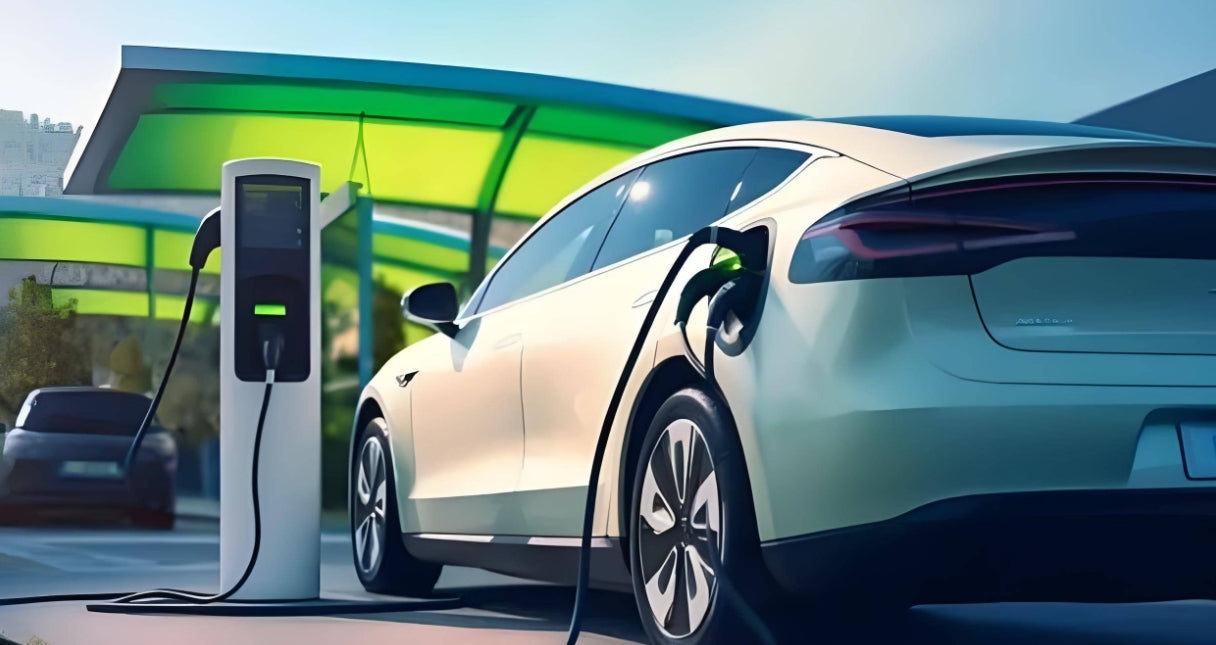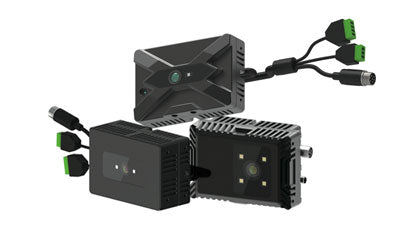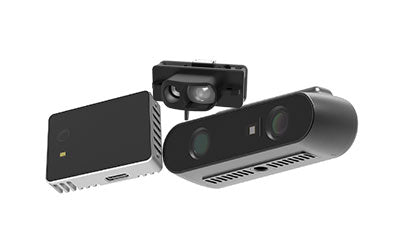LiDAR Sensors and ToF Technology: Driving the Smart EV Revolution

As new energy vehicles (NEVs), especially smart electric cars, continue to rise in popularity, search terms like 'lidar sensors for cars,' 'lidar sensor car,' 'vehicle lidar,' and 'what are lidar sensors' have become hot topics. LiDAR sensors—crucial components of the perception systems in modern smart vehicles—are driving a revolution in automotive intelligence and automation. Behind this advancement is ToF (Time of Flight) technology, the backbone enabling high-precision 3D sensing.
1. What Is LiDAR and Why Is It Essential for New Energy Vehicles?
LiDAR (Light Detection and Ranging) is a high-precision sensing technology based on the principle of time of flight (ToF). It works by emitting laser pulses and calculating the time it takes for the reflected light to return, thereby measuring the distance to the object. When this data is combined, LiDAR creates a real-time, detailed 3D point cloud map that captures the vehicle's surroundings.
Compared to traditional camera systems, LiDAR offers superior depth perception and doesn't rely on visible light. This makes it highly effective under challenging lighting conditions such as nighttime, bright sunlight, fog, or rain. Furthermore, compared to millimeter-wave radar, LiDAR provides significantly higher spatial resolution, allowing it to detect small obstacles and even the posture and outlines of pedestrians, enhancing environmental awareness.
LiDAR plays a critical role in the rise of smart EVs for several reasons:
-
Improving Autonomous Driving Accuracy: Self-driving algorithms require precise input. LiDAR delivers centimeter-level 3D data, helping vehicles make safer, more informed driving decisions.
-
Filling Blind Spots of Cameras and Radar: Multi-sensor fusion is the future of advanced autonomous driving, and LiDAR adds significant value in near-field perception and stereo modeling.
-
Recognizing Complex Urban Environments: From construction zones to unusual road users (e.g., people pushing strollers or small children), LiDAR excels where other sensors fall short, especially for L3–L4 autonomous systems.
-
Enabling a Fully Perceptive Smart Vehicle System: In the smart EV architecture—where electric motors power movement, AI chips act as the brain, and sensors serve as the eyes—LiDAR is the key vision system feeding reliable real-time data to the vehicle’s decision-making unit.
As solid-state LiDAR, MEMS LiDAR, and automotive-grade miniaturized LiDAR become more affordable and reliable, their adoption in mid-to-high-end smart electric vehicles is accelerating. LiDAR is rapidly becoming the essential hardware for building safe, intelligent autonomous systems.
2. ToF Technology: The Core Mechanism Behind 3D Vision in Smart EVs
What is a ToF time of flight sensor?
ToF (Time of Flight) is an optical distance-measuring technology and the core principle behind LiDAR. It works by emitting high-speed laser pulses and measuring how long it takes for the reflected light to return to the sensor. This allows the system to compute precise distances and generate high-resolution depth maps and 3D point clouds.
Compared to traditional image processing methods, ToF excels in spatial sensing and provides several key advantages:
-
Fast and Accurate: ToF can gather depth information in milliseconds—ideal for real-time hazard response in autonomous driving.
-
All-Weather Performance: Since it doesn't rely on ambient light, ToF functions reliably at night and under adverse lighting conditions like fog, rain, or glare.
-
Real-Time 3D Perception: ToF continuously captures high-frame-rate depth data, offering consistent 3D input for AI algorithms.
In smart EVs, ToF is expanding beyond external perception to enable immersive, intelligent in-cabin experiences:
Exterior: Mapping and Obstacle Avoidance
Combined with LiDAR, ToF gives EVs centimeter-level precision in identifying road edges, small obstacles, and dynamic pedestrian behavior—vital for safe, real-time autonomous navigation.
Interior: The Birth of the Intelligent Cockpit
-
Driver Monitoring Systems (DMS)
ToF cameras track facial expressions, eye movements, and head positions in real time to detect fatigue or distraction. Alerts or automated assistance features are triggered to ensure safety. -
Passenger Sensing
ToF identifies how many passengers are in the vehicle, whether they're seated properly, or if seatbelts are fastened—enabling automatic climate and seat adjustments. -
Gesture Control
Hand gestures detected by ToF sensors allow for contactless control of media, navigation, or windows, providing a futuristic, hygienic user experience.
As smart electric vehicles become more intelligent and user-centric, ToF is laying the groundwork for next-generation safety and immersive interaction platforms. Especially in L2+ to L4 autonomous levels and luxury MPV smart cabins, ToF—when combined with AI chips and multi-modal sensors—is accelerating the evolution of automotive intelligence.
3. Key Applications of LiDAR and ToF in Smart Electric Vehicles
1. Autonomous Driving and ADAS (Advanced Driver Assistance Systems)
Smart EVs from brands like Tesla, XPeng, NIO, Li Auto, and others are integrating front, side, and panoramic LiDAR sensors to detect vehicles, pedestrians, bicycles, traffic lights, and structures. These sensors enable early risk detection and predictive driving behavior—essential for L3–L5 autonomous systems.
2. Smart Parking and Urban Low-Speed Navigation
In urban settings, LiDAR delivers centimeter-accurate distance measurements for precise and safe parking. Combined with cameras and ultrasonic sensors, LiDAR enhances the accuracy and reliability of intelligent parking systems.
3. In-Cabin Sensing: Creating a Perceptive Smart Cockpit
As NEVs shift toward intelligent, personalized experiences, interior sensing systems are becoming a key differentiator. Many high-end EV brands (like Tesla, NIO, XPeng, and Mercedes EQ series) are now integrating ToF sensors in the cabin. Their superior 3D recognition capabilities offer users a safer and more intuitive experience:
-
Driver Fatigue Detection & Attention Monitoring
ToF sensors monitor eye closure, blink frequency, and head posture in real time. If signs of drowsiness or distraction are detected, the system triggers alerts or activates driver-assist functions. -
Child Presence Detection & Safety Integration
ToF can detect micro-movements inside the cabin, even if a sleeping child is left behind. If a child is detected after the vehicle is locked, the system may open windows, trigger alarms, or send alerts to the owner's smartphone to prevent tragedies like heatstroke. -
Gesture Control & Touchless Interaction
ToF enables hand tracking for touch-free control of audio, lighting, and sunroofs, delivering futuristic interactions—especially relevant in a post-pandemic world. -
Smart Seat Recognition & Safety Synchronization
ToF identifies whether each seat is occupied, determines occupant posture and body type, and automatically adjusts seating positions, ventilation, and safety features such as airbags. -
Behavioral Monitoring & Personalized Services
Future ToF integrations will analyze passenger emotions, gesture habits, and even identity, allowing for real-time adjustments in lighting, music, and cabin ambiance.
In the confined and ever-changing cabin environment, ToF’s high resolution, low latency, and resistance to light interference make it an indispensable component of the smart cockpit. It enhances human-vehicle interaction while strengthening the technological appeal of EV brands.
4. Energy Optimization and Route Planning
By providing highly accurate environmental data, EVs can better predict road conditions and adjust acceleration or regenerative braking accordingly. This optimizes battery usage and enhances range efficiency.
4. Why Do NEVs Need LiDAR More Than Traditional Vehicles?
Smart EVs are inherently more compatible with high-precision sensors due to their electric architecture and integrated digital control platforms. Compared to fuel-powered cars, EVs offer:
-
More Powerful Computing: Onboard AI chips process LiDAR point clouds in real time.
-
Software-Defined Architecture: Facilitates OTA updates for ongoing LiDAR algorithm improvements.
-
Lightweight Designs: Easier to integrate compact solid-state LiDAR across vehicle models.
In short, LiDAR is not just an extra set of eyes—it’s the perception engine enabling NEVs to deliver a safer, smarter driving experience.
5. Future Trends: Accelerated LiDAR Adoption, Expanding ToF Applications
Solid-state, Flash, and miniaturized automotive-grade LiDAR are evolving rapidly, becoming smaller, cheaper, and more precise. Mid-range EVs are now beginning to adopt these technologies. Meanwhile, ToF is also booming in smart homes, security, and robotics—creating a diverse, cross-industry sensing ecosystem.
With growing policy support and technological progress, LiDAR + ToF is poised to become a standard in next-generation EVs. Together, they ensure safe, energy-efficient, and intelligent mobility.
Conclusion: LiDAR Is Powering the Future of Smart Mobility
LiDAR and ToF technologies are redefining what's possible in smart electric vehicles. From enhancing safety and energy efficiency to delivering intelligent in-cabin experiences, LiDAR is no longer a premium add-on—it is becoming the core sensory engine for the era of autonomous, connected electric mobility.
With the rising popularity of terms like 'lidar sensors for cars,' 'lidar sensor car,' and 'vehicle lidar,' it's clear that LiDAR will continue to play a central role in the smart mobility revolution.
Synexens Industrial Outdoor 4m TOF Sensor Depth 3D Camera Rangefinder_CS40p
After-sales Support:
Our professional technical team specializing in 3D camera ranging is ready to assist you at any time. Whether you encounter any issues with your TOF camera after purchase or need clarification on TOF technology, feel free to contact us anytime. We are committed to providing high-quality technical after-sales service and user experience, ensuring your peace of mind in both shopping and using our products.






